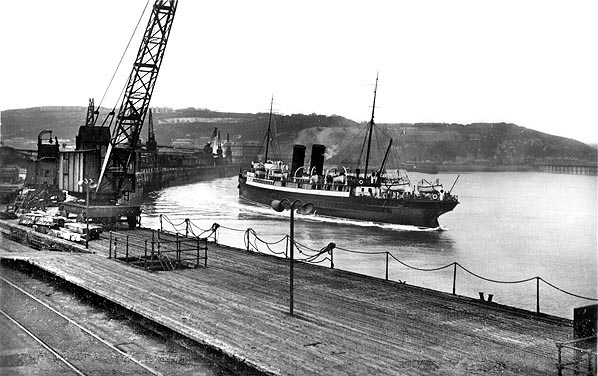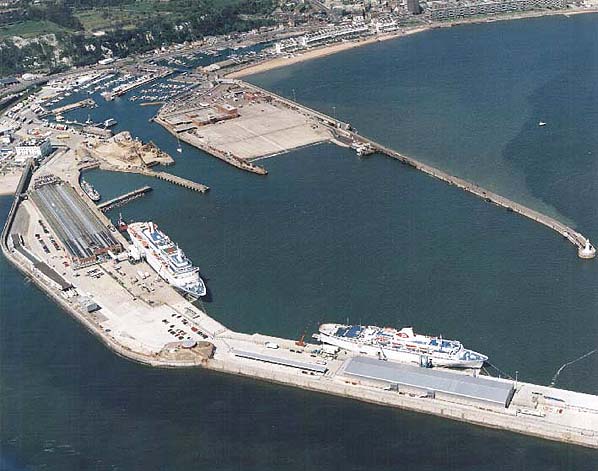
Station Name: DOVER ADMIRALTY PIER[Source:Nick
Catford]
Dover Admiralty Pier Gallery 3: 1906 - January 2015 old1.jpg)
The 'Empress' is seen moored beside the new passenger platform that was opened in 1906. The 'Empress' was built for the LC&DR by Fairfield Shipbuilding & Engineering Ltd, Govan, in 1887. After 19 years’ service the vessel was withdrawn in 1906 and broken up. The loco Wainwrights E Class No.273. A development of his successful D Class 4-4-0 built at Ashford works, this loco entered service in February 1906 and lasted in service until withdrawal in December 1951, having been numbered 31273 by British Railways. Note the large SE&CR hand barrows stored at the end of the platform. Click hereto see a hand-tinted version of this original photograph.
Copyright photo from John Alsop collection old2.jpg)
Another view of the new platform looking south-east on the same day in 1906. The central section of the new station beneath the canopy was made of concrete but the two ends were of timber construction.
Copyright photo from John Alsop collection  The north end of the new Admiralty Pier passenger platform.
Photo from Jim Lake collection pier_old23.jpg)
SE & CR locomotive No. 504 is seen alongside the turret military complex c1910. This loco was built at Ashford works to HS Wainwrights E Class design in 1906 to haul the first class traffic between Victoria and Dover. It was rebuilt in 1920 to an E1 class design by Maunsell and was eventually withdrawn from Stewarts Lane shed in February 1958 having been numbered 31504 by BR. An unidentified paddle steamer is moored at the pier on the far left. The tower in the background is the Pier Turret Battery command post which was built on top of the old lighthouse.
Photo from John Mann collection pier_old39.jpg)
A profusion of porters lines up on the narrow platform as a boat train arrives behind E class 4-4-0 No.514 in March 1910. This view shows the original platform on the west side of the pier beneath the promenade. When the second platform opened in 1906 this platform remained in use. Harry Wainwright designed the E Class of 4-4-0 tender locomotives for express passenger trains on the South Eastern & Chatham Railway. This loco was built at Ashford works in January 1908. It was renumbered 1514 by the Southern Railway receiving a ‘3’ prefix under BR. It was withdrawn from Stewarts Lane shed in October 1951 and cut up at Eastleigh works the following year. No E class locomotives have
survived into preservation. Photo reproduced with permission from Middleton Press 'South Coast Railways - Ashford to Dover' pier_old28.jpg) Looking south-east along the Admiralty Pier during WW1. All passenger services ended in 1914 with the pier coming under military control. Dover was a key location during WW1 as a major embarkation port for all three services.
pier_old35.jpg)
With the opening of Dover Marine station on 18 January 1919 the platforms on the Admiralty Pier remained closed after WW1. The disused 1906 platform is seen in this view from the promenade taken in the 1930s.
pier5.jpg)
Looking north-west along the Admiralty Pier in September 1973. Dover Western Docks station is seen on the right. The pedestrian entrance to the station is opposite the ‘Lord Warden’ Hotel which is seen in the background. From there a covered walkway with a bridge across the tracks leads into the station, which is seen here. There is also a door with steps down onto the pier which is still popular
with local fishermen. Photo by John Mann pier1.jpg) 73 122 is seen on the Admiralty Pier on a scorching summer’s afternoon in July 1983 with a train of soft fruit in wooden vans from Spain and refrigerated vans from Italy and Spain. The train having been assembled off the train ferry will, during the evening, form 6R80 22.10 to Paddock Wood where the train’s contents will be loaded onto road vehicles for onward distribution across the south of England. When the old train ferry shut in 1987 these sidings were revamped and became the link to the new train ferry located roughly where the rear of this train is seen. The original passenger platform was largely beneath the promenade, terminating approximately where the loco is now seen. The later platform started a few yards round the first bend in the pier which is seen here; it was to the left of the line running alongside the train.
Photo by Adrian Nichols from his Flckr photostream pier2.jpg)
Looking south-east from the Admiralty Pier promenade in April 1995. The original platform was beneath the promenade. The 1906 platform's northern end was just beyond the second diesel loco.
Photo by Brian Creasey pier3.jpg)
Looking north-west from the turret, the pier promenade is seen on the left. The 1906 platform and landing stages were where the four lines of cars are seen to the east of the promenade. Everything to the east of the cars is land reclaimed from the harbour.
Photo
by Paul Wells
pier4.jpg)
Admiralty Pier seen from the Western Heights in January 2015. The original west side of the pier is still clearly seen with the turret around the second bend and the pier extension beyond that. Everything to the left is land reclaimed from the harbour. The ‘Lord Warden’ Hotel is seen in the foreground and, behind it, Dover Marine station which was renamed Dover Western Docks in 1979. The station eventually closed on 25 September 1994 and the Grade II listed building is now a ferry terminal. The high level covered pedestrian entrance to the station is seen above the north end of the promenade with a bridge across the now-lifted sidings into the station. The site of Dover Town station is on the right, opposite the hotel; it is now used as a car and lorry park.
Photo
Paul Wells
pier7.jpg)
Looking north-west from the pier promenade in Mat 2015. The two earlier platforms end on to each other were sited beneath the promenade the later platform was in the foreground where the line of cars on the left are seen in May 2015. The Dover Western Docks trainshed is seen on the right.
Photo
by Nick Catford

Dover's Inner Harbour is seen from the air with the Admiralty Pier forming the west boundary. The pier was completed in 1871 with the turret at the pierhead, which is seen below the bow of the cruise liner on the left. The pier was extended a further 2,000ft bring its final length to 4,140ft. To the east of the pier a large part of the inner harbour has been reclaimed from the sea to form the Dover cruise terminal 1 which opened in 1996. The terminal building is the former Western Docks station; this is seen centre left. As a listed building many of the original features are still evident although the trackbed has been filled up to platform level. Immediately to the north of the terminal building is the ‘Lord Warden’ Hotel and to the east of the hotel is the freight clearance facility. Cruise terminal 2, which opened in 2000, is on reclaimed land to the east of the pier extension. This is the busiest of Dover's 3 cruise terminals and tends to be used by the larger cruise ships. The east side of the inner harbour is the Prince of Wales Pier; here, too, a large portion of the harbour has been reclaimed to create Dover's Hoverport. This opened in 1978, closed in November 2005 with the withdrawal of the Seacat service and was demolished in 2009; the site awaits redevelopment. Closer to the shore is a marina and, to the north of that, Granville Dock. A road bridge crosses the marina, immediately north of the Prince of Wales Pier. Another marina and Wellington Dock are to the east of the bridge.
 Home
Page Home
Page
|
pier_old_thumb37.jpg)
pier_old_thumb14.jpg)
pier_old_thumb16.jpg)
pier_old_thumb17.jpg)
pier_old_thumb44.jpg)
pier_thumb8.jpg)
